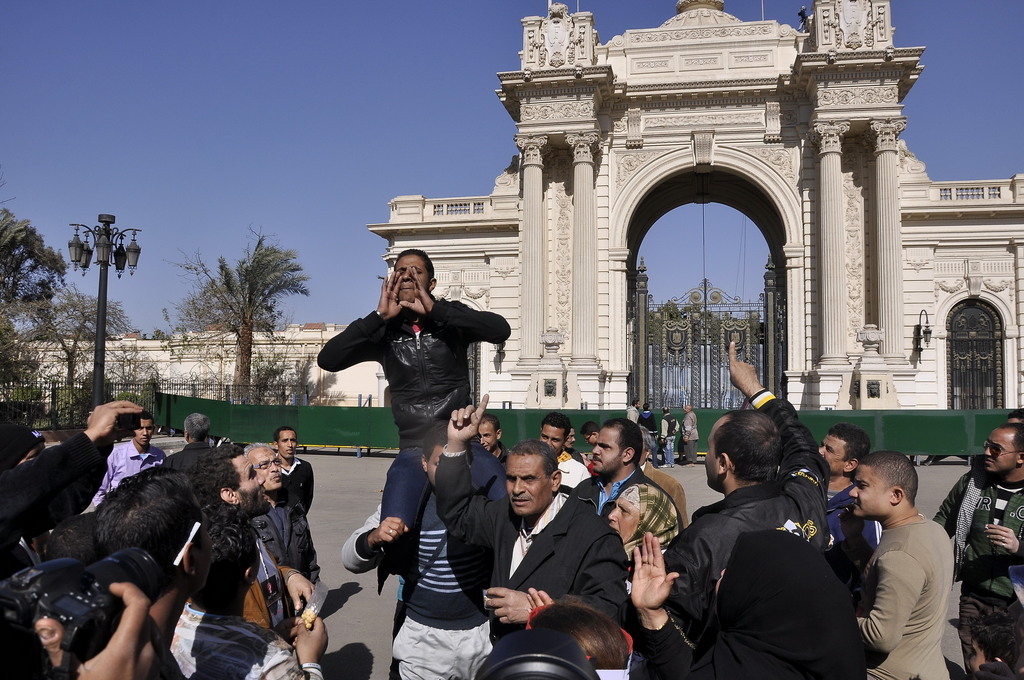Along the walkway to the Sawy Culture Wheel’s River Hall where the Street Theater Festival was to unfold over the course of the entire Saturday, were cut-out images of Cairene life: a man driving a horse-carriage, a Tannoura dancer, a juice seller.
Later during the day, the chalk provided for graffiti art had produced an amusing effect: the horse was asking the driver to “Have mercy, you meanie! and the juice-seller was smoking a piece of chalk. The popular line advertising television channel Melody Tunes “All Ingelesh, All Za Tayem also made an appearance.
Inside the pre-painted graffiti walls had equally interesting anecdotes of Egyptian life: a batata (sweet potato) seller asking people to buy his warm batata, football player Mohamed Zidan, men carrying bread trays on their head, veiled women passing by markets selling gowns.
Spots along the riverside venue were labeled after different Cairene locations: Mohamed Aly St., Mounira, Rod El-Farag and so on. A circle with street signs marked a midan (square) around which wicker chairs and tables were arranged to resemble a street-side café. Games of backgammon and chess were also placed on tables with a view of the Nile. Classic Om Kolthoum’s songs were the background score to visitors entering the scene before the official opening.
The festival was opened by Sawy director Mohamed El-Sawy when a large enough crowd had gathered. The street theater festival aimed to revive Egyptian traditions. The first act was an interactive clown performance by a troupe of four. Children as well as adults were invited to throw hoops that a clown gathered around his neck. Another clown made balloon animals and flowers and gave them away to the audience. Whenever the audience seemed less than enthusiastic, the clowns mimed that they were asleep, prompting them to deliver rounds of applause.
Music was the next featured avenue into Egyptian life. The husky wooden sound of the nay (flute) elicited rhythmic claps from the audience. The eastern takht (ensemble) of the qanun (zither) and tambourine played along to a song beginning with the ever-traditional “Ya Leili (O Night). The selection also included instrumental versions of popular numbers to which the audience contributed the words, singing along and clapping. A beat-box performance, somewhat out of place but nevertheless well-received, was also in the evening’s musical repertoire.
No Egyptian street scene would be complete without the aroma of food wafting through. Kebda (liver) with bread, fuul and aish (bread) with pickles, and koshari were all available at rates that would compete with the inexpensive ones on the high-end location of the Culture Wheel. Drinks included the traditional tamarind, dob, and sobya, and quickly ran out.
Nestled in one corner was a scene not much visited upon the more developed streets of Cairo: a street-barber cutting a child’s hair or shaving a man’s beard. Another unusual scene was the sight of a tok-tok (rickshaw) inside the Culture Wheel, carrying amused children in circles around a tree, which director Sawy announced as the first tok-tok in Zamalek.
Audiences of all ages attended the festival, from a young girl in red ribbons dancing, to an elderly couple clapping to the music, and young college-goers snapping pictures of the graffiti and playing with the barber’s equipment.
Celebrations included a monkey show, another band performance and a “dragon man performance with a man throwing fire from his mouth. The festival continued well into the night, so those that missed events in the day would have caught the repeated performance in the night.
The animation at the festival was not unlike the graffiti painted on the walls, whose characters had stepped out along the Nile turning the River Hall into a lively Cairo street scene filled with bustle, food, and music.

